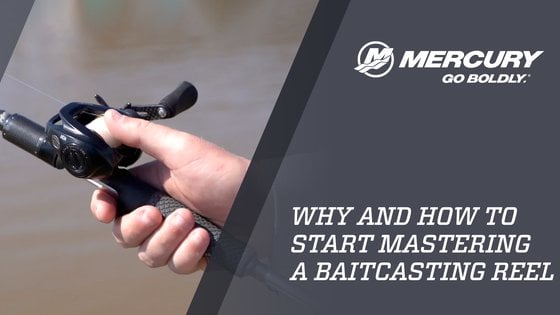Mercury Pro Team member Andy Montgomery, of Blacksburg, South Carolina, is well-known in fishing circles for being a casting wizard. The Major League Fishing Bass Pro Tour angler can place a lure anywhere he wants around cover and obstructions, and his tool of choice most of the time is a baitcasting rod and reel combo. While Montgomery’s casts are dazzling to watch and casting at his level is a desirable skill to possess, the pro’s love for accurate casting is all for the purpose of one thing – catching more fish.
“People ask me all the time in seminars how they can catch more fish. It’s simple: Become a better caster,” Montgomery said. “It doesn’t matter what bait you’re using, if you are a more accurate caster and put your bait in the ‘strike zone’ with longer casts, or you put your bait in the ‘strike zone’ more times by putting it right beside a piece of cover, you’re going to catch more fish.”
In addition, a careful cast that lands quietly – particularly in close-quarters situations – is often more likely to get bit than a loud, splashy cast, because the quiet presentation “surprises” the fish and is less likely to spook them away.
According to Montgomery, the most effective way to make casts that are stealthy, long, accurate or some combination of the three is with a baitcasting rod and reel. Though spinning and push-button reels have their time and place for bass anglers, it pays to become proficient with baitcasting tackle for better success.
Use the Brakes
Over the past decade, advancements in reel technology have made using baitcasting reels much easier. The spool can be controlled by adjusting the reel’s brakes. The brakes use either magnetic or centrifugal force to control the speed that the spool can turn. By adjusting the brakes, you can help prevent overruns that cause backlashes and dial in the reel for different types of lures or casts.
Montgomery has worked with tackle company Lew’s on a signature series of baitcasting rods and reels, including a reel perfected for skipping a bait, an advanced casting method at which Montgomery excels. His reels use magnetic brakes to control the spool.
“When you’re first starting out, make sure and turn the magnetic tension as high as possible,” Montgomery said. “That’s going to greatly reduce your backlashes, which will greatly reduce your frustration.”
As you progress in your skill development, you’ll learn to adjust the brakes based on the situation. Generally, it’s best to increase the brakes in situations where backlashes are more likely, like when casting into the wind. Decrease the braking pressure when casting heavy lures or making underhand pitches, since pitching is easiest with a free-spinning spool. Ultimately, the key is to experiment to find what works best for you.
Use Your Thumb
The manual part of the baitcasting process is to use your thumb to control the spool. On a long cast, applying steady, light thumb pressure on the spool helps prevent the spool from spinning too fast and backlashing. On a short, pinpoint cast, “feather” the spool by gradually applying more pressure to slow the lure before it lands. This will help to gently lay the lure on the water and minimize the splash. It’s a technique where the baitcaster shines and is not possible with spinning and push-button reels.
“I grew up using a push-button,” Montgomery said. “My granddaddy was probably the best I’ve ever seen with a push-button. He could lay a bait right beside a dock pole nearly every time, but it would make a really big splash.
“With a baitcaster, we can feather the spool and slow a bait down to make it ease into the water. We can ‘surprise’ fish and make them bite. That’s the main reason a baitcaster is a must.”
So, why should you learn to use a baitcaster? For Montgomery, the answer is simple: “It will make you a better caster, and better casts lead to catching more fish.”
For more from Andy Montgomery, follow him on Facebook and Instagram.




